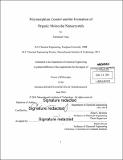| dc.contributor.advisor | Allan S. Myerson. | en_US |
| dc.contributor.author | Yang, Xiaochuan, Ph. D. Massachusetts Institute of Technology | en_US |
| dc.contributor.other | Massachusetts Institute of Technology. Department of Chemical Engineering. | en_US |
| dc.date.accessioned | 2014-10-21T17:24:04Z | |
| dc.date.available | 2014-10-21T17:24:04Z | |
| dc.date.copyright | 2014 | en_US |
| dc.date.issued | 2014 | en_US |
| dc.identifier.uri | http://hdl.handle.net/1721.1/91067 | |
| dc.description | Thesis: Ph. D., Massachusetts Institute of Technology, Department of Chemical Engineering, 2014. | en_US |
| dc.description | Cataloged from PDF version of thesis. | en_US |
| dc.description | Includes bibliographical references. | en_US |
| dc.description.abstract | The formation of organic molecular nanocrystals is a topic of great interest in the pharmaceutical industry because of the potential increase in dissolution rate and solubility of organic crystals below 1 ptm and their potential use in drug products. Previous investigators have developed various methods to produce them; however, breakage, high supersaturation and high intensity mixing are often involved in those methods, producing amorphous solids and if crystalline solid is obtained making control of desired polymorphs difficult. The aim of this thesis is to: (1) Evaluate practical methods to produce organic molecular nano-crystals of the desired form; (2) determine the change in crystal solid properties with size; (3) develop a better fundamental understanding of nucleation kinetics during concomitant nucleation of polymorphs. The first approach tried used bi-functional Self-Assembled Monolayers (SAMs) substrates. Using mefenamic acid as the model compound, micro-sized and nano-sized crystals were obtained with controlled polymorphs and narrow size distributions. By tuning experimental conditions and surface chemistry, exclusive production of one polymorph was demonstrated as well. On the 1 ptm gold islands a single crystal was obtained on each of the islands with a crystal size of ~ 300 nm. The second approach is crystallization under nano-sized confinement. Using soft confinement (porous polymer membranes), we reported the use of a novel solution impregnation method to form nanocrystals in polymer matrices with various microstructures to systemically study the role of soft confinement and polymer chemistry on the nucleation process of nano-sized crystals. We obtained 100% crystalline materials of four compounds in all experiments and in most cases nanocrystals were the most stable form. The smallest nanocrystals produced were ~ 100 nm. In the rigid confinement (porous silica particles of ~ 40nm pores), we explored the polymorphic outcome of four different compounds using solid state NMR. We found that three out of the four compounds can crystallize in the pores although one showed two polymorphs concomitantly crystallized the same time and another one produces a mixture of two polymorphs and amorphous states. All these nanocrystals under soft and rigid confinement showed significant enhancement of dissolution profiles. These results help advance the fundamental understanding of nucleation under rigid confinement and may lead to potential applications in developing new formulations in the pharmaceutical industry. The third approach is the use of nano spray drying. We used glycine as the model compound and compare this approach with the first one we developed, and the results suggest that the nanocrystals produced by spraying exhibit wider size distribution and worse surface structures. These defects existing on crystal surface may improve mobility of molecules and cause "crystal-bridging" to form big crystals. To explore the change in crystal solid properties regarding size, we also measured the solubility vs size curves of two polymorphs of glycine. Both polymorphs showed 20%-30% increase of solubility when crystal size goes down to -300 nm. Although the curves did not cross in the range that we measured, the extended trends suggested that p-glycine solubility could be lower than [beta]-glycine when the crystal size is smaller than ~100 nm. | en_US |
| dc.description.statementofresponsibility | by Xiaochuan Yang. | en_US |
| dc.format.extent | 164 pages | en_US |
| dc.language.iso | eng | en_US |
| dc.publisher | Massachusetts Institute of Technology | en_US |
| dc.rights | M.I.T. theses are protected by copyright. They may be viewed from this source for any purpose, but reproduction or distribution in any format is prohibited without written permission. See provided URL for inquiries about permission. | en_US |
| dc.rights.uri | http://dspace.mit.edu/handle/1721.1/7582 | en_US |
| dc.subject | Chemical Engineering. | en_US |
| dc.title | Polymorphism control and the formation of organic molecular nanocrystals | en_US |
| dc.type | Thesis | en_US |
| dc.description.degree | Ph. D. | en_US |
| dc.contributor.department | Massachusetts Institute of Technology. Department of Chemical Engineering | |
| dc.identifier.oclc | 892344946 | en_US |
